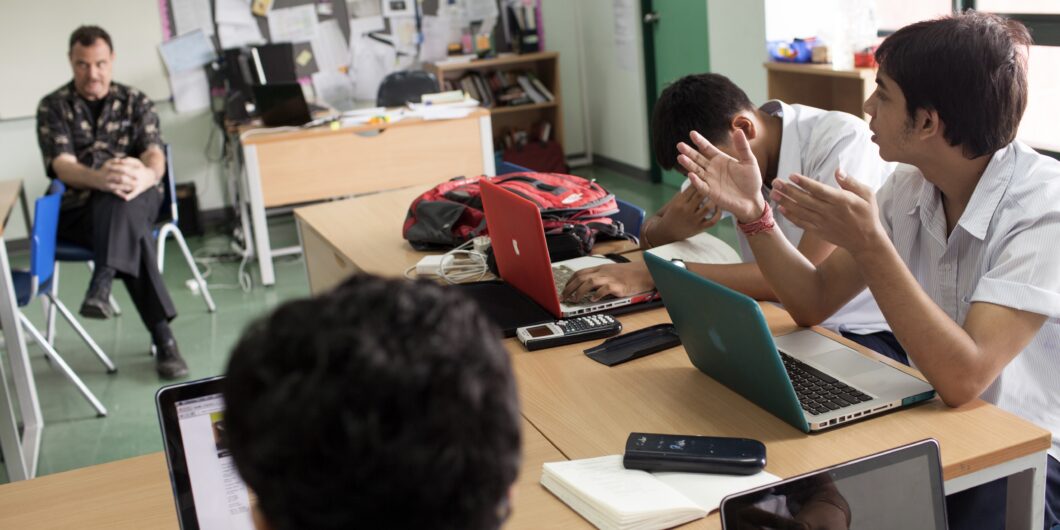The growing chasm between law professors and the practicing bench and bar should make the legal academy think differently about hiring faculty.
Sympathy for the Devil
Universities are one of the United States’ greatest strengths. Throughout the nation’s history, institutions of higher education have promoted free thought and open discourse, which are crucial to maintaining our stable democracy and unparalleled economic growth. Attendance was viewed as a clear benefit for both the student and society. But the legitimacy of American higher education is under attack and for good reason: many graduates now leave campus with an intellectual rigidity and homogeneity of viewpoint that is lethal to a pluralistic society.
We need our institutions of higher education. They are the best vehicles we have for upward mobility and the promotion of democracy. But if we hope to salvage them in the public eye, we must recognize that professors are fighting an uphill battle against students’ tendency to conform, and pedagogical choices have serious implications when students leave campus and enter society.
A psychological experiment sheds light on how today’s college students today adopt a new set of views so quickly and why free speech in the classroom, particularly teaching students to weigh both sides of an argument, is vital to preserving our social fabric.
The Power of Groupthink
Perhaps the most famous social psychological experiment demonstrating the power of conformity was conducted by Solomon Asch in the 1950s. The experiment started with a simple task: participants were shown a card with a straight line on it (the reference card) and then shown a series of other cards, with varying line lengths, and asked to say aloud which one matched the original reference card. This was a straightforward vision test: Participants got it wrong less than 1% of the time.
Then, Asch introduced a group, unbeknownst to the study participants, who had been instructed in advance to match the line with one that was blatantly incorrect. The participants faced the choice to stick to their answer, the right one, or follow the group making a clear error. The first time the participants answered incorrectly, along with the group, 36% of the time. But once it was repeated, the results were shocking. After twelve questions, 70% of the participants followed the group to pick the blatantly incorrect choice.
The results of Asch’s experiment doubled with repetition: Fewer than half of participants yielded to an answer they knew was blatantly incorrect the first time, but 70% had joined the pack once the exercise was repeated multiple times. Repeated messaging, regardless of the degree to which it violates what we know to be true, can be very potent, so potent that 70% of people will reject observable reality to conform.
The study was recently replicated in 2023 and Asch’s findings remain true today. Researchers also extended the experiment to political opinion and found that 38% of participants conformed if the discussion was political in nature. For example, when asked in isolation whether trade unions should have more power, 29% of participants said yes. When social conformity conditions were imposed—and the majority of the group answered in the affirmative—72% of participants said yes. A 43% difference in opinion, attributable solely to a change in group dynamics.
The Campus Fishbowl
What does this tell us about classrooms? Social forces are extremely powerful, so powerful that they often overcome our sense of truth and convince us to follow the crowd even when our inner monologue counsels otherwise. In the classroom, students are increasingly exposed to one-sided points of view on everything from contemporary politics to health and biology. Parents might equip their children with a strong sense of self and sharp critical thinking before they flee the nest, but it’s often no match for our innate desire to belong. This is particularly true for young women, who are more susceptible to conformity.
Solomon Asch’s participants were conscious of the fact they were engaged in a scientific experiment and conformed all the same. These results, if replicated with college-age students who are severed from their usual support systems while away at school, would likely be much worse given the heightened desire for social conformity during adolescence. Unlike Asch’s participants, college students cannot just leave the experiment and shake off the shame of appearing ignorant—they learn, socialize, and live with their “co-participants” for four years. Belonging is everything.
Conformity, even in the face of contrary evidence, is exacerbated by the fact that college students usually lack information about the topic at hand—that is why they are there, of course, to learn. But when we lack information about a given topic, our tendency to rely on the opinions of others is at its peak. Particularly when the majority of the group appears to hold the same view.
Standing up for the Devil’s Advocate is crucial: students need to toughen up, particularly when it comes to the “words are violence” maxim that has taken hold in academia.
There is also an element of epistemic humility at work: if an entire group disagrees with a perspective, it is probably a good idea to re-evaluate. A society characterized by unfettered self-assurance would be a scary place indeed. But increasingly, there is a significant possibility that the mainstream view on campus is nothing but the publicly recognized view of elite academia. Therefore, students might be acting under the false assumption that the group’s homogenous point of view is the product of individual reason and logic when it is mere deference to the academic mainstream.
Asch’s results are replicated in many American classrooms. Take October 7th, for example, where a startling number of students abandoned their sense of truth and critical thinking in exchange for social acceptance. Many students were quick to label Israelis, and Jews more broadly, as “white settler-colonialists” (despite the fact they are neither white nor colonizers) and to glorify Hamas, a named terrorist group, in the face of overwhelming evidence to the contrary. This one-sided narrative has a vice grip on many college campuses. Most students know very little about the history of the conflict, making them all the more susceptible to narratives that are far removed from reality.
One need only see a sign that says “Queers for Palestine” to see how far astray conformity can drag those caught in its grip. But not all is lost. There is one powerful antidote to conformity.
In another iteration of Asch’s experiment, planted participants chose the incorrect line, but this time, one individual, one voice of sanity, chose correctly. Total errors were reduced by 75%, even in cases where the planted majority still chose the incorrect line.
This shows why free speech and diversity of thought matter so much.
We yearn to belong, and homogeneity of viewpoint can convince us to abandon our priors and go with the pack, but one courageous person can give our psyche a lifeboat—if it’s important enough, we might just jump ship.
The Devil’s Advocate
Lone contrarians are rare in classrooms given the social costs. Professors can create the illusion of them, however, by reviving the Devil’s Advocate.
The Devil’s Advocate, a process where students are tasked with representing a side of an argument they disagree with, used to be a ubiquitous pedagogical tool. In-class debates were frequent and students were tasked with representing a particular view, whether or not they held it themselves. It was not uncommon for students to write a final paper weighing both sides of a particular issue.
Now, much of the academy views the Devil’s Advocate as unproductive, and perhaps harmful—opponents claim the tool emotionally taxes the students who disagree with the expressed perspective.
For instance, a 2017 op-ed argued that use of the Devil’s Advocate in conversations over affirmative action is nothing but a tool for white people to secretly espouse their racist views; it is “disingenuous on the part of white people and emotionally strenuous for those of us forced to entertain it. … If the psychic conflict that results from this is distressing for an adult, that kind of emotional and mental labor being demanded from a child can be harrowing.”
Having opposing views, even on contentious issues, is acceptable and part of living in a pluralistic society like ours.
The Devil’s Advocate should not be used as a front to share abhorrent opinions. Racism has no place in the classroom—or anywhere for that matter. But surely, a professor can identify a reasonable range of views that are defensible and worthy of debate without opening the floor to truly dehumanizing propositions. Racial questions are particularly difficult in our time, but harsh criticism of this pedagogical tool is not confined to hot-button issues like affirmative action. A Center for Conflict Resolution recently recognized that while the use of the Devil’s Advocate “improves group decision outcomes,” participants feel “a threat to their self-esteem, belonging, need for control and a meaningful existence, all of which are associated with poorer health and well-being.”
To put it plainly, opponents who claim the tool itself is the problem conflate a symptom with the larger epidemic. Participants do not feel an existential threat because of the use of the Devil’s Advocate; rather, they break down when they encounter dissent because they are products of a culture where disagreement is no longer an expected part of a healthy discourse. We have neutered people’s ability to confront intellectual adversity and then blame the vehicle instead of ourselves.
Standing up for the Devil’s Advocate is crucial: students need to toughen up, particularly when it comes to the “words are violence” maxim that has taken hold in academia. Asch’s research demonstrates that this tool is a surefire way to reduce conformity to erroneous information.
Many professors have found that this exercise helps students to think more critically, and to examine the views of others with more care. Professor David Olson of Boston College Law School told me, “I regularly ask students to state the counterargument to whatever point has just been made in class. Students don’t tend to do this on their own, but they will do it when pushed. I’ve found that habituating students to search for arguments on both sides of an issue helps develop critical analysis over groupthink.”
Asking students to express both sides of any particular argument for the sake of argument can, at best, teach critical thinking skills, and at the very least, generate the illusion of diversity of opinion when it’s lacking. In essence, it recreates Asch’s lone “voice of sanity” and emboldens students to express beliefs they know to be true, counteracting the coercive social forces that promote homogeneity of thought. For students who hold the majority view and wish to marginalize minority viewpoints, the Devil’s Advocate encourages some intellectual humility.
Perhaps most importantly, it teaches students that having opposing views, even on contentious issues, is acceptable and part of living in a pluralistic society like ours.
System-wide change in academia presents some daunting challenges. Years of rewarding leftist thinking among graduate students have left us with a professoriate that is unrepresentative of the population in terms of political viewpoint. It will take time to cultivate ideological diversity among higher education faculty. But for now, the least we can do is revive a pedagogical tool that gives students a fighting chance to think freely.



